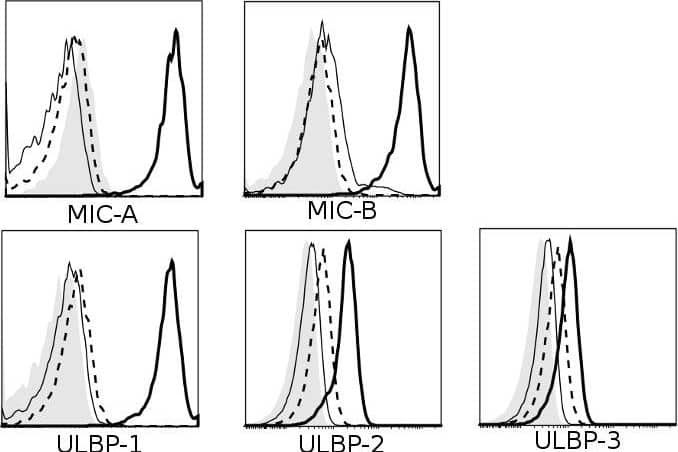Human ULBP-2/5/6 Antibody Best Seller
R&D Systems, part of Bio-Techne | Catalog # MAB1298


Conjugate
Catalog #
Key Product Details
Species Reactivity
Validated:
Human
Cited:
Human
Applications
Validated:
Blockade of Receptor-ligand Interaction, CyTOF-ready, Flow Cytometry
Cited:
ELISA Development, ELISA Development (Detection), Flow Cytometry, Functional Assay, Immunocytochemistry, Immunohistochemistry, Immunoprecipitation, Neutralization
Label
Unconjugated
Antibody Source
Monoclonal Mouse IgG2A Clone # 165903
Product Specifications
Immunogen
BaF3 mouse pro-B cell line transfected with human ULBP-2
Accession # Q9BZM5
Accession # Q9BZM5
Specificity
Detects human ULBP-2 and human RAET1L/ULBP-6 in direct ELISA and stains cells transfected with human ULBP-2, human ULBP-5 or human RAET1L/ULBP-6 in flow cytometry. In direct ELISA, 11% cross‑reactivity with recombinant human ULBP5 is observed. It does not stain cells transfected with human ULBP-1 or human ULBP-3 in flow cytometry.
Clonality
Monoclonal
Host
Mouse
Isotype
IgG2A
Endotoxin Level
<0.10 EU per 1 μg of the antibody by the LAL method.
Scientific Data Images for Human ULBP-2/5/6 Antibody
Detection of ULBP-2/5/6 in HT1080 Human Cell Line by Flow Cytometry.
HT1080 human fibrosarcoma cell line was stained with Mouse Anti-Human ULBP-2/5/6 Monoclonal Antibody (Catalog # MAB1298, filled histogram) or isotype control antibody (Catalog # MAB0031, open histogram), followed by Allophycocyanin-conjugated Anti-Mouse IgG Secondary Antibody (Catalog # F0101B).Detection of Human ULBP-2/5/6 by Flow Cytometry
Multiple receptors and ligands are involved in NK cell-mediated lysis of activated CD4+ T cells.Role of (A) activating and (B) inhibitory NK receptors in NK cell degranulation. Left column: representative histograms (of n≥3) for surface expression of ligands on activated (thick black line) and resting CD4+ T cells (thin black line). Isotype-matched control Ig are represented by dashed line (activated CD4+ T) and filled histogram (resting CD4+ T). Middle- and right column: NK and CD4+ T cells were activated for 4 days in vitro as described, and co-cultured for 4 hours with 10 ug/mL mAb (or relevant isotype-matched control Ig). Degranulation is shown for CD56dim (middle column) and CD56bright (right column) NK cells. Representative histograms of surface expression of receptors on activated (thick black line) and resting NK cells (thin black line). Isotype-matched control Ig are represented by dashed line (activated NK) and filled histogram (resting NK). * P<0.05, ** P<0.005, *** P<0.001. (C) Sorted IL-2-activated CD56dim and CD56bright NK cells were co-cultured with 51Cr-labeled activated CD4+ T cells in a 51Cr-release assay with human IgG4 isotype control (•) or anti-NKG2A mAb (○). Data represents n = 3 experiments. Image collected and cropped by CiteAb from the following publication (https://pubmed.ncbi.nlm.nih.gov/22384114), licensed under a CC-BY license. Not internally tested by R&D Systems.Applications for Human ULBP-2/5/6 Antibody
Application
Recommended Usage
Blockade of Receptor-ligand Interaction
In a functional ELISA, 0.03 - 0.1 μg/mL of this antibody will block 50% of the binding of 25 ng/mL of biotinylated rhULBP-2/Fc to immobilized rhNKG2D/Fc chimera coated at 2 μg/mL (100 μL/well). At 1 μg/mL, this antibody will achieve 85% blocking in the assay. This antibody will block >70% of the binding of either Recombinant Human ULBP-5 Fc Chimera or Recombinant ULBP-6 Fc Chimera to immobilized Recombinant Human NKG2D Fc Chimera.
CyTOF-ready
Ready to be labeled using established conjugation methods. No BSA or other carrier proteins that could interfere with conjugation.
Flow Cytometry
0.25 µg/106 cells
Sample: HT1080 human fibrosarcoma cell line
Sample: HT1080 human fibrosarcoma cell line
Reviewed Applications
Read 1 review rated 5 using MAB1298 in the following applications:
Formulation, Preparation, and Storage
Purification
Protein A or G purified from hybridoma culture supernatant
Reconstitution
Reconstitute at 0.5 mg/mL in sterile PBS. For liquid material, refer to CoA for concentration.
Formulation
Lyophilized from a 0.2 μm filtered solution in PBS with Trehalose. *Small pack size (SP) is supplied either lyophilized or as a 0.2 µm filtered solution in PBS.
Shipping
Lyophilized product is shipped at ambient temperature. Liquid small pack size (-SP) is shipped with polar packs. Upon receipt, store immediately at the temperature recommended below.
Stability & Storage
Use a manual defrost freezer and avoid repeated freeze-thaw cycles.
- 12 months from date of receipt, -20 to -70 °C as supplied.
- 1 month, 2 to 8 °C under sterile conditions after reconstitution.
- 6 months, -20 to -70 °C under sterile conditions after reconstitution.
Background: ULBP-2/5/6
References
- Cosman, D. et al. (2001) Immunity 14:123.
- Kubin, M. et al. (2001) Eur. J. Immunol. 31:1428.
- Sutherland, C. et al. (2002) J. Immunol. 168:671.
- Steinle, A. et al. (2001) Immunogenetics 53:279.
- Sutherland, C. et al. (2001) Immunol. Rev. 181:185.
- Pende, D. et al. (2002) Cancer Res. 62:6178.
- Radosavljevic, M. et al. (2002) Genomics 79:114.
- NKG2D and its Ligands (2002) www.RnDSystems.com.
Long Name
UL16 Binding Protein-2/5/6
Alternate Names
ALCAN-alpha, N2DL2, NKG2DL2, RAET1H, RAET1L, UL16 binding protein 2, ULBP2
UniProt
Additional ULBP-2/5/6 Products
Product Documents for Human ULBP-2/5/6 Antibody
Product Specific Notices for Human ULBP-2/5/6 Antibody
For research use only
